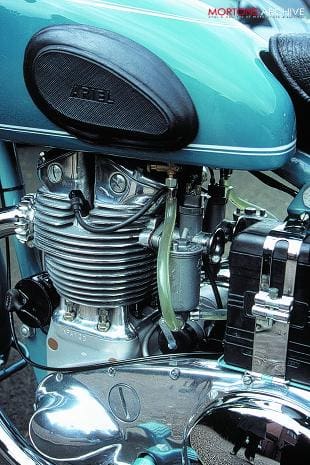
Ariel’s smooth 500cc KH twin was a Val Page design of the early 50s, the Selly Oak company’s answer to the parallel twin vogue that Triumph started in 1937 and the rest of the British industry was forced to follow in the 1940s and 50s to keep up their sales.
Never mind that Ariel had some mighty fine singles and the unique Square Four, they were in a market competing for custom all over the world, and the world was twin-cylinder crazy. The KH was produced with an all-iron top and the all-alloy KHA as an option; these are rare indeed today and Arielists prize them very highly. With the head and barrel polished up to match the timing cover, gearbox end plate and primary chaincase, they are downright dazzling – guaranteed to make ‘em stop and ogle at any classic bike show.
But there’s a special version of the KHA in existence, a twin-carburettor model that’s obviously meant to be rather sporty, and CBG had the chance to look it over before restorer Graham Horne delivered it to the National Motor Cycle Museum. The cylinder head is clearly non-standard, with quite separate inlet tracts for the carbs, while the standard head has the single-carb mounting and the tracts to the two cylinders all within the casting. This version could be adapted to a single carburetter with a manifold, but that was clearly not the idea at all; this is the sporting 500 Ariel Twin that didn’t make it to the production line. Finished in the Wedgwood blue that was a one-year-only option for the 1953 season, it’s a very handsome motorcycle with white lining and lots of polished alloy. “If you’d had one of those back in 1953, you’d have been a very proud man indeed,” as Graham Horne put it.
Why didn’t the KHA in single carb form, never mind this more sporting twin Amal version, progress and establish a place in the Ariel range? Graham believes that the cast iron guides for the cam followers, which in Val Page’s design were located at the outer ends of each camshaft (in effect at each corner of the cylinder block) were inclined to work loose when the bike was worked hard and the engine became hot. The different rates of expansion of alloy and cast iron would account for that; the logical solution would have been to peg them in place if development had continued.
The engine number is XFA100, which has no obvious significance as XFA was the normal KHA number prefix. But careful examination of the cylinder head shows ‘EX’ cast into the fins, which suggests an experimental unit. This one should be back with the museum by the time you read this, but before it disappeared into Mr Horne’s van we couldn’t resist a quick, round-the-block squirt on a unique motorcycle.
It’s standard 1953 Ariel in the rolling chassis department, with the unloved Anstey rear suspension, while the exhaust note through a pair of pattern Burgess silencers is deep and crisp, suggestive of an engine intended to get a move on along the open road. But that was not for us, just a rapid run up the road and back, which showed the bike light to handle and the engine very responsive and willing. The fact that it’s not registered for the road did rather inhibit our brief ride. Ahem.
You can see it in the museum, which is on the junction of the A45 and M42, another handsome motorcycle that reminds us what might have been if the Ariel factory at Selly Oak had been given a little more leeway by their BSA owners to work on their original designs. Another one to file under ‘if only’. ![]()




